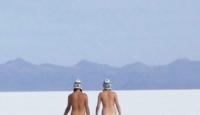

-
11 June 2015
- From the section Magazine

Four Western tourists, including a Briton, have been arrested in Malaysia for allegedly taking naked pictures on a mountaintop considered sacred by tribes. Is this a growing phenomenon, asks Justin Parkinson.
A group of 10 people reportedly stripped off to take photographs of themselves on Malaysia’s Mount Kinabalu. Four people have been arrested and could be charged with causing a public nuisance.
Mount Kinibalu is believed by local tribes to house the spirits of dead ancestors, with some of the more superstitious even linking the disturbance to a fatal earthquake that took place last week.
Several famous tourist attractions, including places of religious significance, are being used for naked images in the same way by holidaymakers and gap-year travellers.
Disrobing at Machu Picchu, a 15th-Century Inca citadel in the Peruvian Andes, designated as a Unesco world heritage site, has resulted in several arrests. Two sisters from Arizona were arrested and fined in February for taking pictures of their buttocks inside the Angkor Wat temple, while three French men were deported for similar offences.

Many more have got away without police action, posting their pictures on Facebook. One page shows a nude man standing in front of Rio de Janeiro’s Christ the Redeemer statue and mimicking its pose.
There’s a picture of another naked man standing in a shot of Australia’s Uluru, or Ayer’s Rock. Paris’s Eiffel Tower, the Great Wall of China and Bolivia’s Salar de Uyuni, the world’s largest salt flat, have received similar treatment.
“It was an act of friendship and stepping out of our comfort zone,” says one of four men who revealed their bottoms in a picture taken at the Grand Canyon. The location “simply added to that moment”, he adds. “There was no one else but us there so we didn’t think anyone would be offended.
“However, all of us have also travelled around Asia together and I don’t think any of us would have done something that would disrespect the culture. America, on the other hand, is a lot more liberal.”

Those punished for taking naked photos of themselves have only themselves to blame, says Simon Calder, senior travel editor for the Independent newspaper, who has himself climbed Mount Kinabalu. “When you step off into another country, remember that it has its own rules and you should observe them,” he adds. “You might not agree with what you consider conservative cultural beliefs, but that’s not relevant.
“The top of Mount Kinabalu isn’t some empty place. It’s a rite of passage for many Malaysians to climb it. There would have been hundreds of people around [when the photos were taken].” Calder thinks the exotically-placed naked photograph has “definitely increased in popularity”.
Is it becoming part of the Western gap year rite of passage? “There seems to be a challenge for people going travelling to get more and more extreme,” says Sandi Mann, senior lecturer in psychology at the University of Central Lancashire. “Standing next to a wall naked wouldn’t have half the impact of a naked body juxtaposed with a famous monument.”
Mann says that people’s need to be admired on social media for their daring is “sad”. It means that Westerners are imposing themselves on other peoples and “trying to demonstrate to people on Facebook, Twitter and other sites that they’ve had ‘wild experiences’ rather than actually experiencing a culture, which is the whole point of travel in the first place”, she adds.
Subscribe to the BBC News Magazine’s email newsletter to get articles sent to your inbox.

